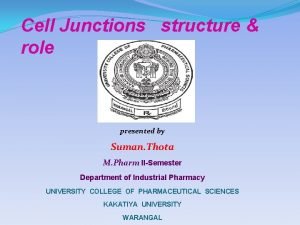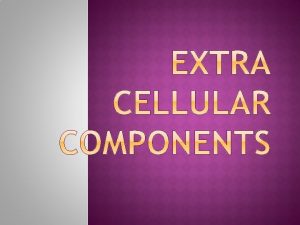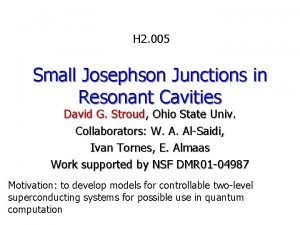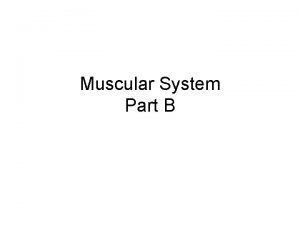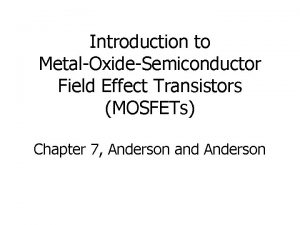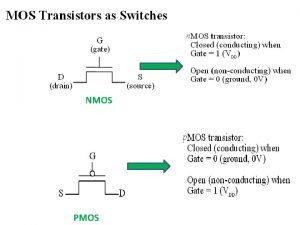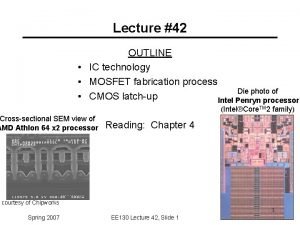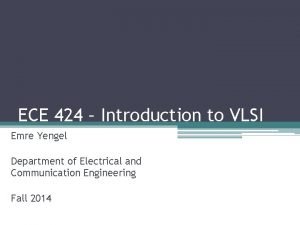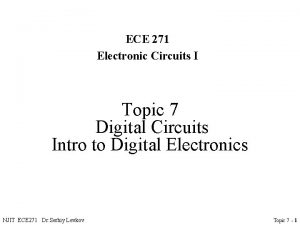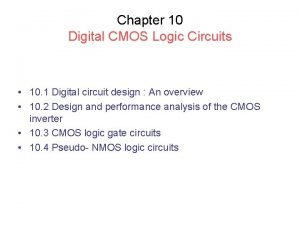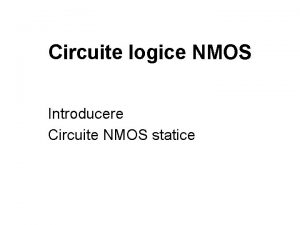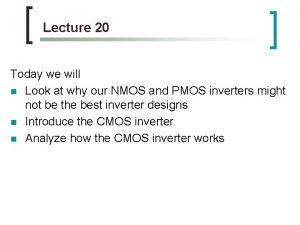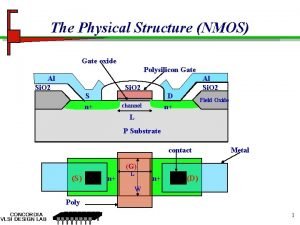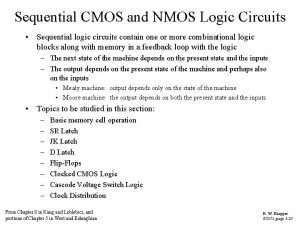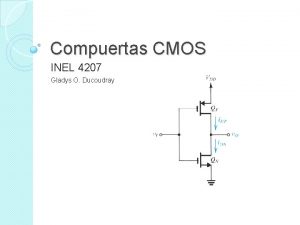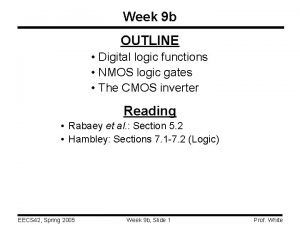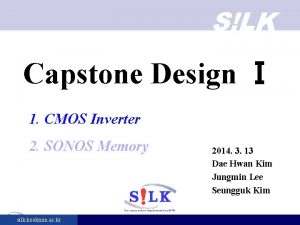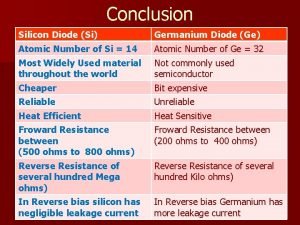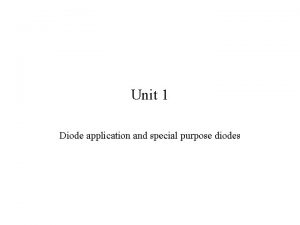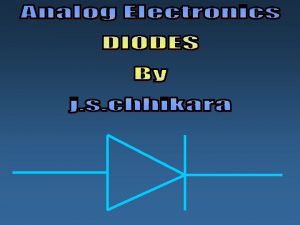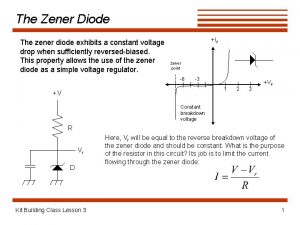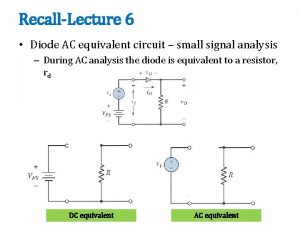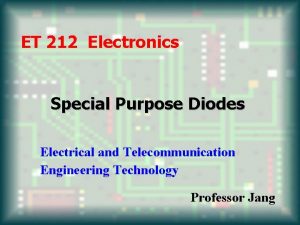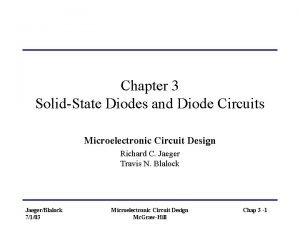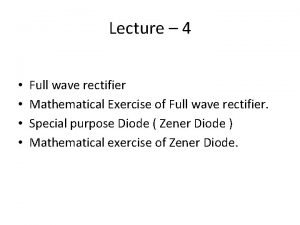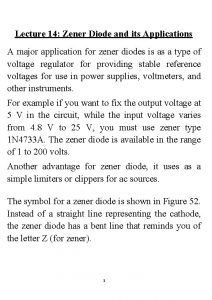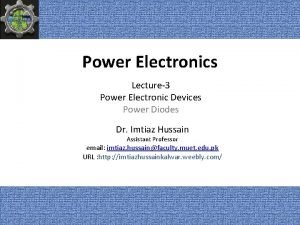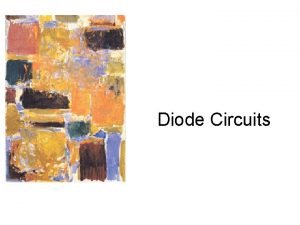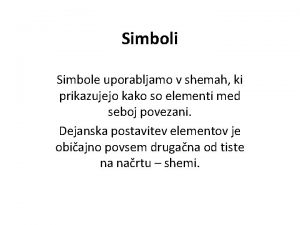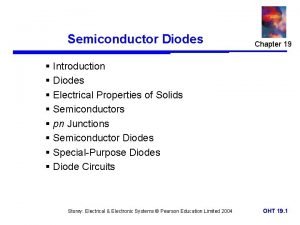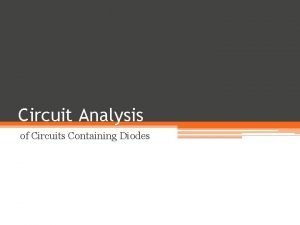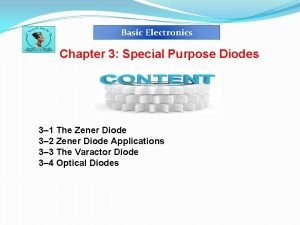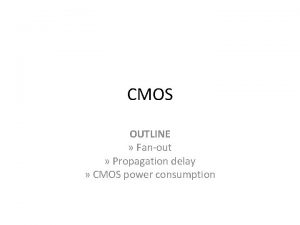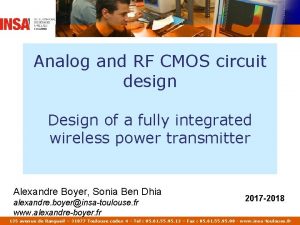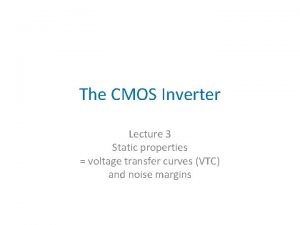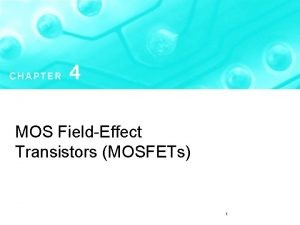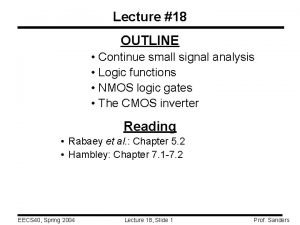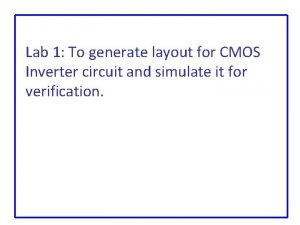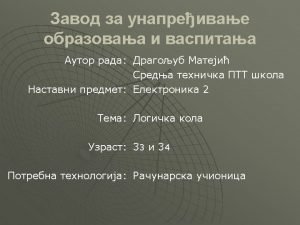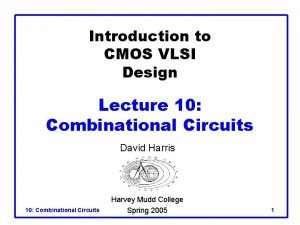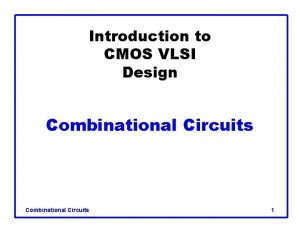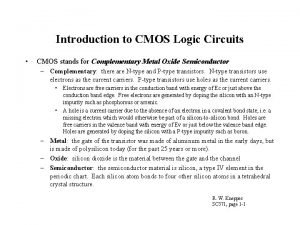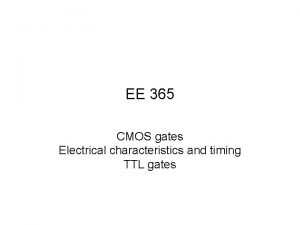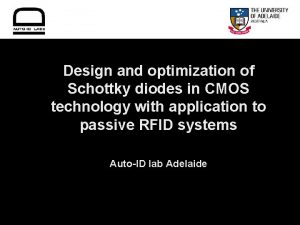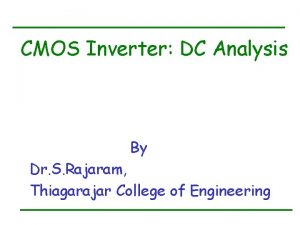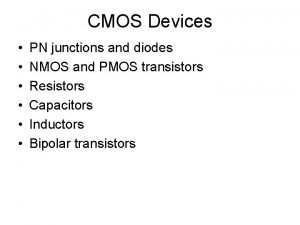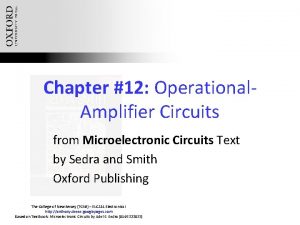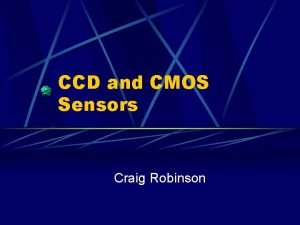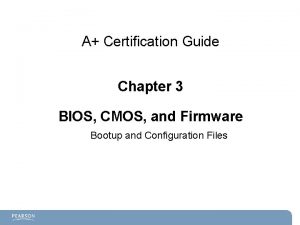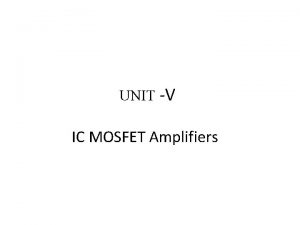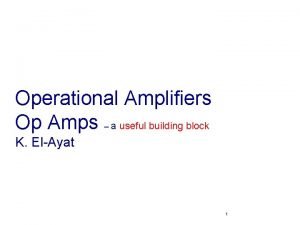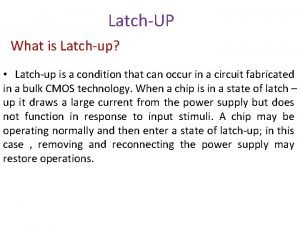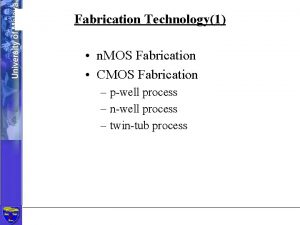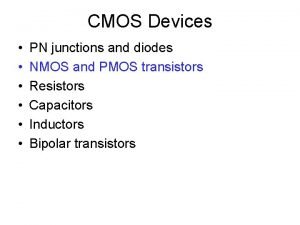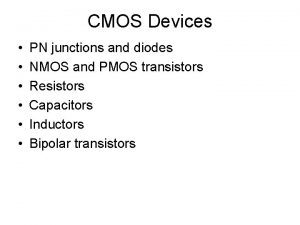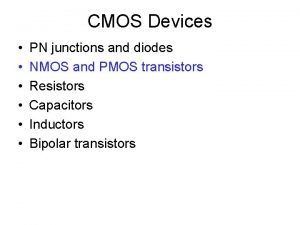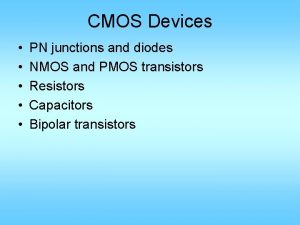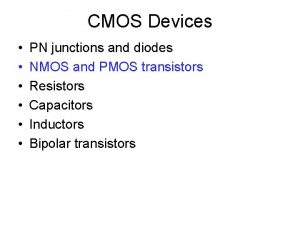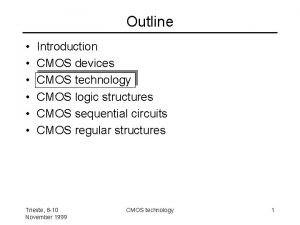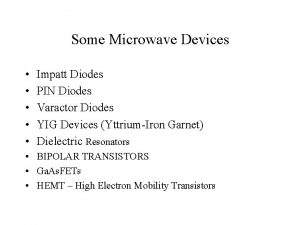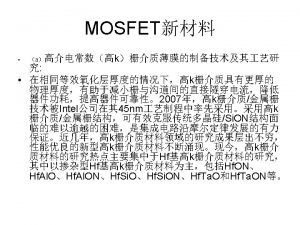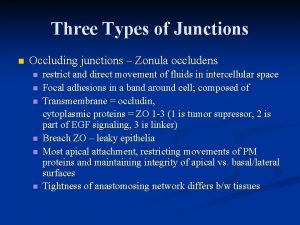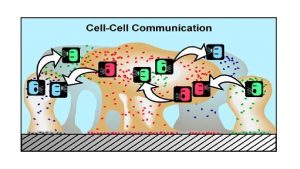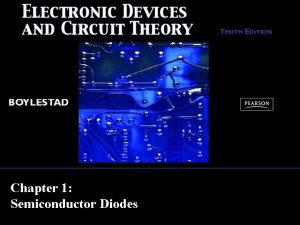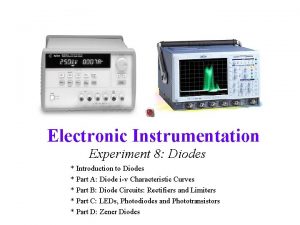CMOS Devices PN junctions and diodes NMOS and






































































- Slides: 70

CMOS Devices • • • PN junctions and diodes NMOS and PMOS transistors Resistors Capacitors Inductors Bipolar transistors

PN Junctions Charges on two sides equal but opposite sign.

pn junction 1. Doped atoms near the metallurgical junction lose their free carriers by diffusion. 2. As these fixed atoms lose their free carriers, they build up an electric field, which opposes the diffusion mechanism. 3. Equilibrium conditions are reached when: Current due to diffusion = Current due to electric field

PN Junctions • Diffusion causes depletion region • D. R. is void of carriers and therefore is an insulator. D. R. establishes barrier voltage. • This leads to 1 -directional current flow – Reverse voltage D. R. , no current – Sufficient forward voltage overcomes barrier and produces current • Forms junction capacitor – Capacitance highly voltage dependent – Can be nuisance or benefits

Abrupt PN Junctions Initial impurity concentration

PN Junctions

PN Junctions Depletion region widths: Built-in potential:

Example • NA=10^15 atoms/cm^3, ND=10^16, v. D=-10 • Ni=2. 25*10^20 • Phi_o=26 ln(10^15*10^16/2. 25/10^20)=638 m. V • xp= - 3. 5 mm • xn= 0. 35 mm • Max field = q*NA*xp/e = -5. 4*10^4 V/cm Note the large magnitude of the field

Excercise • Suppose that v. D = 0, yo = 0. 637 V and ND = 1017 atoms/cm 3. • If NA = 1015 atoms/cm 3 p-side depletion width = ? ? n-side depletion width = ? ? • If NA = 1019 atoms/cm 3: p-side depletion width = ? ? n-side depletion width = ? ?

PN Junctions The depletion charge The junction capacitance

• Can be used as voltage controlled capacitor • Here m = 1/2 for the step change in impurity concentration. • For gradual concentration change, m = 1/3. Real case is somewhere in between.

Impurity concentration profile for diffused pn junction

Current density at boundary due to holes: Total: Diode current:


Reverse-Biased PN Junctions

Breakdown Voltage Our book shows that

Metal-Semiconductor Junctions • Ohmic Junctions: – A pn junction formed by a highly doped semiconductor and metal – Behaves like resistor • Schottky Junctions: – A pn junction formed by a lightly doped semiconductor and metal – Behaves like a diode

The MOS Transistors

Capacitors • Two conductor plates separated by an insulator form a capacitor • Intentional capacitors vs parasitic capacitors • Linear vs nonlinear capacitors Linear capacitors:

Capacitor specifications 1. Dissipation (quality factor) of a capacitor 2. Parasitic capacitors to ground from each node of the capacitor. 3. The density of the capacitor in Farads/area. 4. The absolute and relative accuracies of the capacitor. 5. The Cmax/Cmin ratio which is the largest value of capacitance to the smallest when the capacitor is used as a variable capacitor (varactor). 6. The variation of a variable capacitance with the control voltage (is it linear). 7. Linearity, q = Cv.

PMOS on Substrate Gate Capacitors High density, good matching, but nonlinear

NMOS in p-well Gate Capacitor • Gate as one terminal of the capacitor • Some combination of the source, drain, and bulk as the other terminal

Gate Capacitor vs. VGS with D=S=B

3 -seg Approximation

Gate Capacitor in Inversion Mode

Inversion Mode NMOS Capacitor E. Pedersen, “RF CMOS Varactors for 2 GHz Applications, ” Analog Integrated Circuits and Signal Processing, vol. 26, pp. 27 -36, Jan. 2001.

Accumulation NMOS Gate Cap in n-well

Accumulation Mode NMOS Gate Cap E. Pedersen, “RF CMOS Varactors for 2 GHz Applications, ” Analog Integrated Circuits and Signal Processing, vol. 26, pp. 27 -36, Jan. 2001.

PN Junction Capacitors in a Well

PN-Junction Capacitors E. Pedersen, “RF CMOS Varactors for 2 GHz Applications, ” Analog Integrated Circuits and Signal Processing, vol. 26, pp. 27 -36, Jan. 2001.

Poly-poly cap on FOX High density, good matching, good linearity, but require two-poly processes

Poly-poly cap on STI • Very linear • Small bottom plate parasitics

Metal-insulator-metal cap

Fringe Capacitors

R. Aparicio and A. Hajimiri, “Capacity Limits and Matching Properties of Integrated Capacitors, ” IEEE J. of Solid-State Circuits, vol. 37, no. 3, March 2002, pp. 384 -393.


Comparison

Non-ideal Behavior • • • Dielectric gradients Edge effects Process biases Parasitics Voltage dependence Temperature dependence

Parasitic Capacitors


Proper layout of capacitors For achieving CA = 2 CB, which one is better?

Various Capacitor Errors


Temperature and Voltage Dependence • MOSFET Gate Capacitors: – – Absolute accuracy ≈ ± 10% Relative accuracy ≈ ± 0. 2% Temperature coefficient ≈ +25 ppm/C° Voltage coefficient ≈ -50 ppm/V • Polysilicon-Oxide-Polysilicon Capacitors: – – Absolute accuracy ≈ ± 10% Relative accuracy ≈ ± 0. 2% Temperature coefficient ≈ +25 ppm/C° Voltage coefficient ≈ -20 ppm/V • Metal-Dielectric-Metal Capacitors: – Absolute accuracy ≈ ± 10% – Relative accuracy ≈ ± 0. 6% – Temperature coefficient ≈ +40 ppm/C° – Voltage coefficient ≈ -20 ppm/V, 5 ppm/V 2 • Accuracies depend upon the size of the capacitors.

Improving Cap Matching • Divide each cap into even # of unit caps • Each unit cap is square, has identical construction, has identical vicinity, has identical routing • The unit caps for matching critical caps are laid out with inter-digitation, common centroid, or other advanced techniques. • Same comments apply to resistors and transistors

Resistors in CMOS • • • Diffusion resistor polysilicon resistor well resistor metal layer resistor contact resistor

Resistor specs

Diffusion resistor in n-well

Source/Drain Resistor

Polysilicon resistor on FOX

Polysilicon Resistor

n-well resistor on p-substrate

N-well Resistor

Metal Resistor

Thin Film Resistors

Thermoelectric (Seebeck) Effects • When two materials form a junction, a voltage difference is generated, which depends on the temperature • But a single junction voltage cannot be measured • It needs at least two junctions • The voltage difference is:

Seebeck Coefficients • SA and SB are called Seebeck coefficients of material A and material B • Roughly speaking S is inversely related to the conductivity of the material • Metals have low S, semiconductors have high S • High resistivity materials (with light doping) pose serious thermoelectric problems

Moffat, R. , “Notes on Using Thermocouples”, Electronics. Cooling, Vol. 3, No. 1, 1997

Resistor Layout • But what about horizontal temperature gradient? • Use “antiparallel” layout

X X X X X X HW 1: Prove that if following the arrow, all the metal to poly contacts have the same centroid as all the poly to metal contacts, then thermoelectric effect due to linear thermo gradient is cancelled. HW 2: Generalize HW 1 to design a layout pattern so that thermo-electric effects due to both linear and nonlinear thermo gradients are cancelled.

Suggestions • Use larger area (increase both W and L) to improve accuracy • Use metal to make “turns”, i. e. , use straight strips only • Use unit resistors • Use dummies • Use identical structures and vivinities • Interdigitate, common centroid, and other techniques for good matching

Passive RC Performance

Parasitic Bipolar in CMOS Vertical PNP Horizontal NPN

Latch-up problem

Preventing Latch-up

Guard Rings • Collect carriers flowing in the silicon • Bypass unwanted currents to VDD or VSS • Isolate sensitive circuits from noise and/or interferences

Butted Contacts and Guard Rings • To reduce sensitivity • To prevent latch up

Intentional Bipolar • It is desirable to have the lateral collector current much larger than the vertical collector current. • Lateral BJT generally has good matching. • The lateral BJT can be used as a photodetector with reasonably good efficiency. • Triple well technology allows the current of the vertical collector to avoid the substrate.

Donut PMOS as bipolar • A Field-Aided Lateral BJT – Use minimum channel length – enhance beta to 50 to 100 • Can be done in ON 0. 5 or TSMC 0. 18 – No STI

ESD protection • A very serious problem • Not enough theoretical study • Many trade secrets • Learn from experienced designers
 Desmosome
Desmosome Layers of cell wall
Layers of cell wall Cell junctions definition
Cell junctions definition Intestino delgado pliegues
Intestino delgado pliegues Junction hec ras
Junction hec ras Gap junction in smooth muscle
Gap junction in smooth muscle Josephson junctions
Josephson junctions Asynchronous recruitment of motor units
Asynchronous recruitment of motor units Nmos and pmos symbols
Nmos and pmos symbols Nmos and pmos
Nmos and pmos Cmos
Cmos Static power dissipation in nmos inverter
Static power dissipation in nmos inverter Pmos fabrication process
Pmos fabrication process Ece 424
Ece 424 Ece 271
Ece 271 Saturatiw
Saturatiw Inversor nmos
Inversor nmos Nmos inverter
Nmos inverter Vol voh
Vol voh Nmos
Nmos Iv curve mosfet
Iv curve mosfet Inversor nmos
Inversor nmos Nmos
Nmos Cmos vil
Cmos vil Silicon vs germanium diode
Silicon vs germanium diode Diodes
Diodes State any two special purpose diodes
State any two special purpose diodes What are diodes made of
What are diodes made of Zener diode
Zener diode Ac equivalent circuit of diode
Ac equivalent circuit of diode Special purpose diodes
Special purpose diodes Solid state diode definition
Solid state diode definition Full wave rectifier
Full wave rectifier Advantages of zener diode
Advantages of zener diode Switching characteristics of power diode
Switching characteristics of power diode Practical diode model
Practical diode model Simboli i diodes
Simboli i diodes Introduction to diodes
Introduction to diodes Circuit analysis with diodes
Circuit analysis with diodes Special purpose diodes
Special purpose diodes Logic families characteristics
Logic families characteristics Literary elements and techniques
Literary elements and techniques Input device of computer
Input device of computer Propagation delay in cmos
Propagation delay in cmos Device modeling for analog and rf cmos circuit design
Device modeling for analog and rf cmos circuit design Lod effect sa sb
Lod effect sa sb Idsat definition
Idsat definition Cmos cross section
Cmos cross section Small signal model of cmos inverter
Small signal model of cmos inverter Inverter layout
Inverter layout Cmos invertor
Cmos invertor Skewed gates
Skewed gates Compound gate in vlsi
Compound gate in vlsi Cmos
Cmos Pmos transistor
Pmos transistor Diode layout in cmos
Diode layout in cmos Soi vs bulk cmos
Soi vs bulk cmos Cmos process flow
Cmos process flow Cmos design rules
Cmos design rules Dc analysis of cmos inverter
Dc analysis of cmos inverter Vertical
Vertical Ttl cmos ecl comparison table
Ttl cmos ecl comparison table Cmos amplifier
Cmos amplifier Ccd vs cmos
Ccd vs cmos Cmos certification
Cmos certification Pmos cs amplifier
Pmos cs amplifier Cmos op amp
Cmos op amp Latchup in cmos
Latchup in cmos Eder chavez
Eder chavez Complex cmos logic gates
Complex cmos logic gates Fabrication steps of cmos inverter
Fabrication steps of cmos inverter
